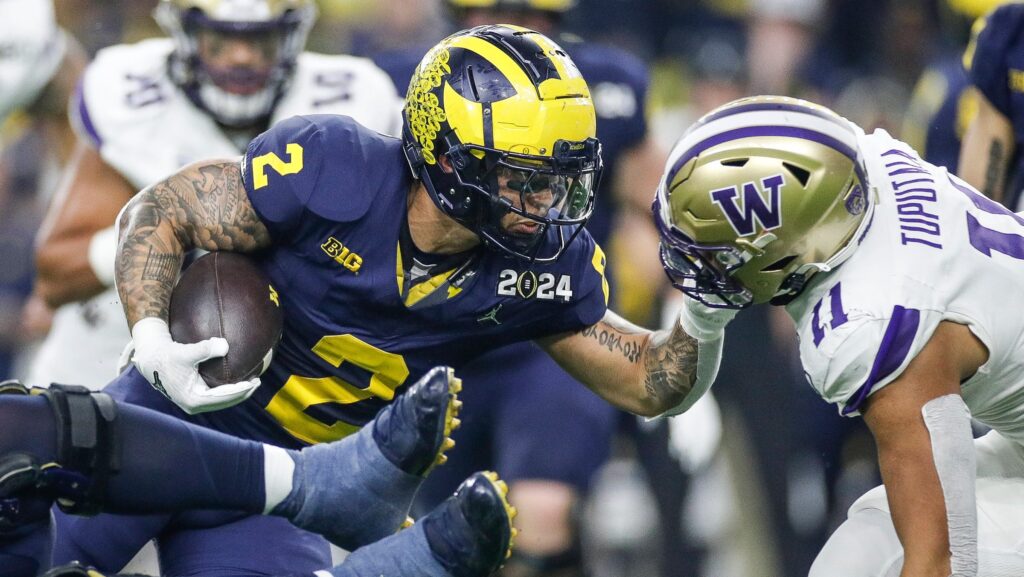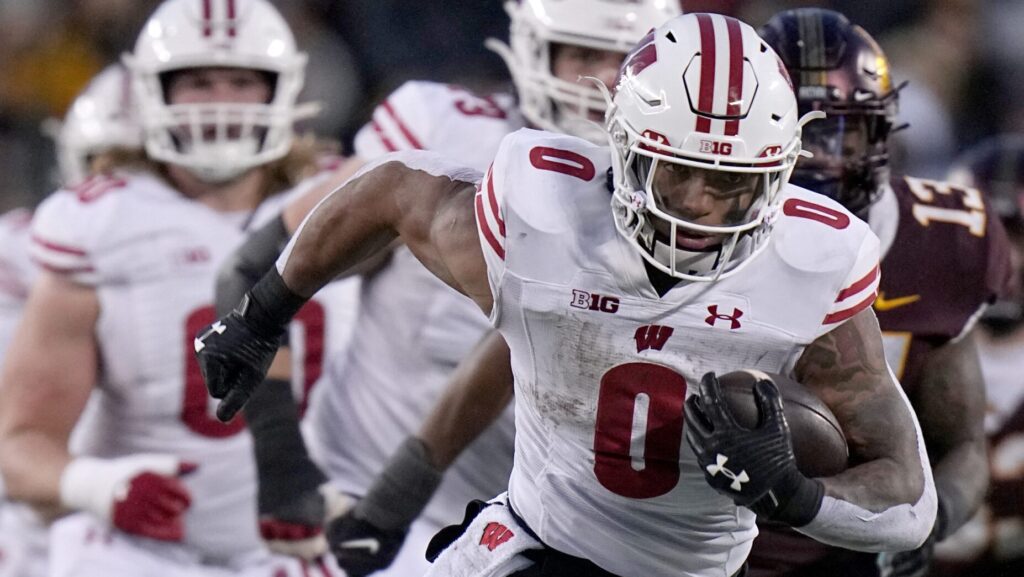Fantasy
1/30/24
7 min read
2024 Dynasty Fantasy Football: Rookie Running Back Prospects You're Too High On

After two columns covering several running backs with optimistic outlooks, we're moving toward a few that make us pause. Two of these running backs often land in the top five or so of running back prospects in the 2024 class based on their college production.
Last time, I mentioned how the 2024 class could be more fruitful when comparing 2022 and 2023. Like anything, context matters, and we'll look at the whole picture to consider the underlying metrics, collegiate production and more to argue why we should temper expectations.
3 RBS WITH PessIMISTIC OUTLOOKS

 Braelon Allen, RB, Wisconsin
Braelon Allen, RB, Wisconsin
Wisconsin has produced several fantasy-viable running backs, so I hesitate to mention Braelon Allen here. Jonathan Taylor, Montee Ball and Melvin Gordon are the three prominent running backs out of Wisconsin since 2010.
As a freshman, Allen had 1,268 rushing yards and 12 scores and followed it up with 1,237 yards and 11 touchdowns as a sophomore. Though Allen saw a downtick as a rusher (984 yards and 12 scores), he matched his receiving yardage market share with five percent in 2023.
Since 2010, Allen would be one of five players entering their rookie season under 21. That list includes JuJu Smith-Schuster, Ronnie Hillman, Brandin Cooks and Israel Abanikanda. Young players matter in the NFL and for dynasty purposes, but we hoped Allen would've posted better running back dominator scores.
Reasons for Optimism
Besides age and early collegiate production, Allen averaged 3.48 yards after contact per attempt (YAC/Att), ranking him 30th among college running backs. That's a solid mark, with his 14.4 percent broken tackle rate (BT+MT/Att) carrying his slightly above average 19.9 percent broken plus missed tackle rate (No. 72). Allen is a tough runner to take down but won’t make many defenders miss.
Allen fights for extra yardage, further evident in his low 12.2 percent stuff rate (No. 22), meaning only 12.2 percent of his carries went for zero or fewer yards. That’s seen in the visual below with the top 12 running backs in stuff rate with a minimum of 150 carries.
Reasons for Concern
Lack of receiving production is one of Allen's red flags. He garnered a 23.1 percent target per route run (No. 85) with an inefficient 1.02 yards per route run (No. 141). Other notable college running backs with similar receiving numbers include Blake Corum, Jase McClellan, Quinshon Judkins and Emani Bailey.
Since 2019, two fantasy-viable running backs averaged 1.0 yards per route run or fewer in a single season. That list includes Clyde Edwards-Helaire at 1.0 (2019), ranking him 156th, and De'Von Achane at 0.8 (2022), ranking him 176th out of 200 running backs.
However, Achane averaged 2.2 yards per route run in 2021, finishing near high-end to elite running backs, including Bijan Robinson, Jahmyr Gibbs and James Cook.
Way Too Early 2024 Outlook
Allen converted from linebacker to running back, similar to Tyler Allgeier. Given Allen's linebacker size, it's easy to see him produce like Allgeier or Derrick Henry as a high-end outcome.
Receiving production and skill matters in college, but don't overweight it. Allen's draft stock has fallen since the college pre-season, but he still projects as a Day 2 selection. If Allen posts above-average athleticism metrics at the NFL Combine, we'll have more confidence in his rookie profile.
 Blake Corum, RB, Michigan
Blake Corum, RB, Michigan
Blake Corum was one of the most dominant college running backs during the past two seasons. Corum averaged a 42 percent Running Back Dominator (RB Dom) with a 44.3 percent team rushing touchdown percentage in 2022.
He followed that up with a 66 percent RB Dom, scoring 66.7 percent of the team's rushing scores. Corum's RB Dom in 2023 ranks ninth in the 2024 class.
He played on a team averaging only 26.4 pass attempts per game. So that's understandable to see Corum dominate as a rusher, yet post a low 3.8 percent receiving yardage market share.
Some of Corum's top comparisons based on college production include Kendre Miller, Tyjae Spears, Sony Michel and Ball. All four of those players produced primarily as a rusher in college, with two still writing their story as 2023 rookies. That’s a solid list, giving us a potential range of outcomes for Corum.
Reasons for Concern
Corum's rushing advanced metrics look concerning, evidenced by his 2.4 YAC/Att (No. 151) and 10.2 percent BT+MT/Att (No. 172) out of 200 qualified college running backs. Unsurprisingly, Corum's YAC/Att ranks last with the BT+MT/Att being third-to-last among the 2024 running back prospects.
Corum injured his knee in November 2022, and then underwent season-ending surgery.
Maybe injury came into play because his 2022 advanced metrics look much better. That's evident in Corum's 3.2 YAC/Att (No. 40) and 23.9 percent BT+MT/Att (No. 34). The data shows much better skills to create yards after contact with the ability to break and force missed tackles at a higher rate before his knee injury.
With Corum's low receiving yardage market share, it doesn't surprise us to find him ranking 160th in TPRR (17.1 percent) and 133rd in YPRR among 200 qualified running backs. That doesn't mean Corum can't catch passes, but we should temper expectations there.
Way Too Early 2024 Outlook
One positive part of Corum's rushing profile involves his low stuff rates. Corum ranked 13th at 9.7 percent in 2023 and 18th with a 12.1 percent stuff rate in 2022. Corum avoids negative yardage with high rushing volume, meaning a low percentage of his rush attempts go for zero or fewer yards.
Early mock drafts have Corum going in the second round as one of the first running backs off the board. Many teams could use Corum, but the 2024 free-agent running back class looks loaded.
We'll see where the athletic measurables shake out because that could cause us to move him up the board, especially with those comparable prospects of Spears, Michel and Ball.

 Will Shipley, RB, Clemson
Will Shipley, RB, Clemson
As a sophomore at Clemson, Will Shipley set career bests in rushing production, with 210 carries, 1,182 rushing yards and 15 rushing touchdowns.
Unfortunately, Shipley's numbers fell to 167 carries, 827 rushing yards and five rushing scores. That translated into a 51 percent RB Dominator, ranking him 15th or middle of the pack among the 2024 class.
He posted a respectable seven percent receiving yardage market share in his first two collegiate seasons. Then, his receiving market share improved to 8.2 percent in 2023. Besides Shipley's receiving market share, he produced inefficiently with 1.30 YPPR (No. 109) via 21.4 percent targets per route run (No. 109) among 200 qualified running backs.
Reasons for Concern
Shipley's rushing metrics don't provide much optimism. He ranks 141st in YAC/Att while breaking and missing tackles 16.8 percent of the time (No. 119). That's below the median and toward the bottom half of the qualified running backs.
If we look at the data from 2022, Shipley ranks 109th in YAC/Att and 132nd in BT+MT/Att at 16.2 percent. That indicates Shipley struggles to evade and shed tacklers in college and likely won't in the NFL.
Way Too Early 2024 Outlook
Some early mocks have Shipley going in the fourth round, around pick 100. That's a bit earlier than other running backs in the class, who showed better metrics in several categories with sleeper appeal.
Unless Shipley blows away the workout metrics, he'll likely profile as an average to below-average running back. The receiving skills could keep Shipley afloat as a third-down back with a lower ceiling like Michael Carter and Justice Hill.






